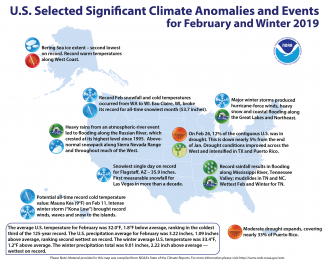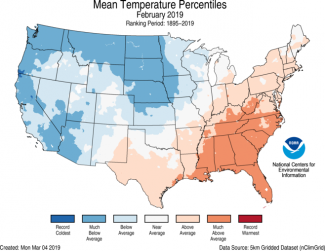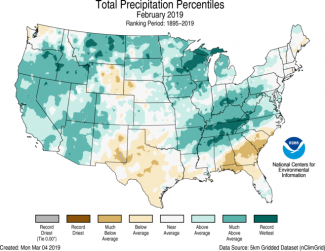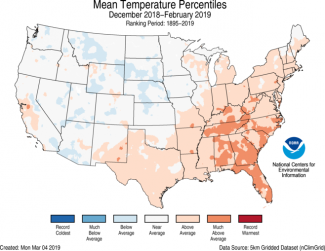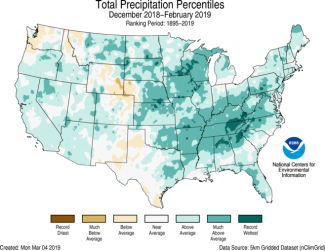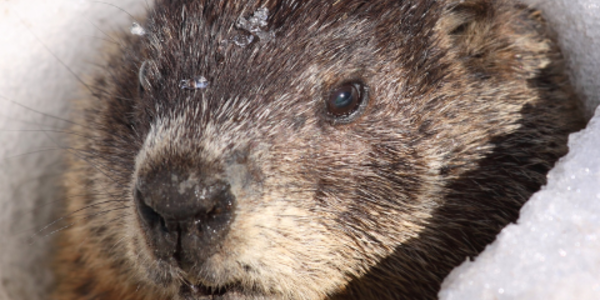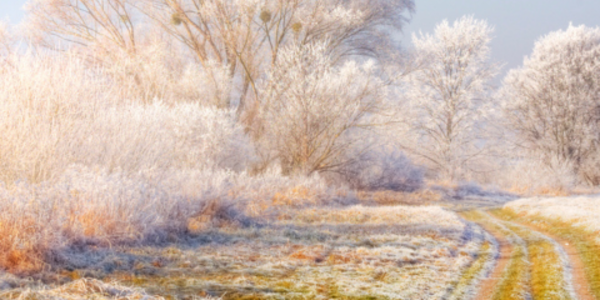Wettest winter on record for the contiguous United States
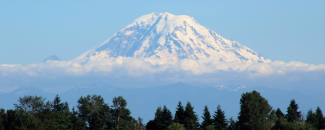
During February, the average contiguous U.S. temperature was 32.0°F, 1.8°F below the 20th century average. This ranked among the coldest third of the 125-year period of record and was the coolest February since 2010. Below- to much-below-average conditions spanned the West and into the Great Lakes states, with above- to much-above-average temperatures observed from Texas to New England. The winter (December–February) average contiguous U.S. temperature was 33.4°F, 1.2°F above average, ranking among the warmest third of the record. Warmer-than-average conditions were present from the southern Plains, across the Southeast and Ohio Valley, and into parts of New England. Pockets of cooler-than-average temperatures occurred in parts of the Rocky Mountains, central to northern Plains and the Southwest.
The February precipitation total for the contiguous U.S. was 3.22 inches, 1.09 inches above average. This was the second highest February precipitation total on record for the nation and only 0.10 inch behind 1998. Record to near-record precipitation fell over parts of the Tennessee and Ohio Valleys as well as across the northern Great Lakes and parts of the Northwest and northern High Plains. The winter precipitation total was 9.01 inches, 2.22 inches above average, and ranked as the wettest winter on record, besting the winter of 1997–98 by 0.02 inch. Much of the West experienced above-average precipitation during the winter season, while broader regions of much-above-average and record precipitation occurred across the Plains, Great Lakes, southern Appalachians, and Mississippi, Ohio and Tennessee River valleys.
This monthly summary from NOAA National Centers for Environmental Information is part of the suite of climate services NOAA provides to government, business, academia and the public to support informed decision-making.
February Temperature
-
Much-above-average temperatures were observed across the Southeast. Florida had its second warmest February on record. Six additional states across the Southeast had a top 10 warm February. Naples, Florida, recorded its warmest February day on the 19th and also the earliest occurrence for a 90°F day on record during the calendar year. Records for Naples began in 1942.
-
Much-below- to below-average temperatures were observed from the West Coast to the Great Lakes. Montana and North Dakota ranked second coldest on record. California, Nebraska, South Dakota and Washington ranked among their 10 coldest Februaries on record. The average monthly temperature for Great Falls, Montana, was nearly 28°F below normal and more than 10°F colder than the previous record set back in 1989. Havre, Montana, also broke a record which was 28°F below normal for the month and bested the previous record by 7°F, set just 12 months ago. This was the coldest February for the state of Montana since 1936.
-
The Alaska February temperature was 14.6°F, 9.8°F above the long-term average. This was the ninth warmest February in the 95-year period of record for the state. The western half of Alaska was much warmer than average, with below- to much-below average temperatures confined to the panhandle. Minimum temperatures for the West Coast division were record warmest during February. Bethel, Cold Bay and Kotzebue had their warmest February on record, while St. Paul had its third warmest. Conversely, Ketchikan had its coldest February since 1936.
February Precipitation
-
Nineteen states from coast-to-coast had a top ten wettest February. Tennessee was record wet for the month with Kentucky and Wisconsin ranking second wettest. Texas, Florida, Georgia and South Carolina precipitation ranked below-average for the month.
-
Rainfall records for the month of February were observed in Knoxville, Tennessee (13.08 inches), Nashville (13.47 inches), Bristol, Tennessee (10.47 inches), Tupelo, Mississippi (15.61 inches), Muscle Shoals, Alabama (14.13 inches), and Huntsville, Alabama (13.63 inches), with widespread flooding occurring along rivers and tributaries as well as mudslides impacting travel for many.
-
Record February snowfall occurred across much of the northern tier of the U.S. from Washington to Wisconsin. Seattle (20.2 inches), Pendleton, Oregon (32.5 inches), Rochester, Minnesota (40.0 inches), Minneapolis (39.0 inches) and Eau Claire, Wisconsin (53.7 inches), all broke February records by impressive margins. In Eau Claire, February 2019 snowfall also set a record for the snowiest of any month on record and surpassed the previous record (32.1 inches in January 1999) by more than 21 inches.
-
According to the February 26 U.S. Drought Monitor report, 11.9 percent of the contiguous U.S. was in drought, down from 16.5 percent at the end of January. Drought conditions improved across the Four Corners region and other parts of the West, while drought conditions worsened across portions of Texas and Puerto Rico.
Winter (December–February) Temperature
-
Above-average winter temperatures were observed across much of the eastern half of the U.S. and also across parts of the Deep South. Florida, Georgia, Alabama and Tennessee had winter temperatures that ranked among their 10 warmest. Despite a very cold two-week stretch across much of the Midwest in late January, cooler-than-average winter temperatures were primarily observed in parts of Montana, Wyoming, South Dakota and Nebraska. No state was record warm or record cold.
-
The Alaska December–February temperature was 10.5°F, 6.9°F above the long-term average, the 13th warmest on record for the state. Much-above-average temperatures spanned the West Coast and North Slope as well as in the Aleutians. Utqiaġvik (Barrow) ranked third warmest.
Winter (December–February) Precipitation
-
Above-average precipitation was observed across all but five of the Lower-48 states. Tennessee ranked wettest, while Wisconsin ranked second wettest. Nineteen states from the Great Plains to the East Coast and south to the Gulf of Mexico ranked in the top 10 wettest on record for winter. No state ranked below-average for winter precipitation.
-
Nome, Alaska, had its second highest winter snowfall (69.8 inches), due in large part to the February snowfall of 35.6 inches — the highest February snowfall reported in Nome since 1920.
-
Omaha, Nebraska, set a new record (46.1 inches) for snowiest winter. The previous record was 44.3 inches and occurred in the winter of 2003–04.

